Over approximately three centuries, several manufacturers
in different French cities, among which Conver, Tourcaty and Camoin (all from
Marseille), Payen (Aix-en-Provence and Marseille), Dodal (Lyon), Noblet (Paris),
and others, produced tarots. Marseille was the city where this art developed
probably more than elsewhere, particularly during the 18th century.
This tradition explains why the name
Tarot de Marseille was chosen
when the early pattern was revived in the 1930s, although it was Lyon that
originally acted as a hinge between the southern and the northern evolution of
the tarot.
In fact, the pattern of Marseille stretched to the
north of the country, as well, although here other influences caused some local
tarots to differ for a number of features, such as the so-called
Tarot de Paris.
By the late 18th-early 19th century the production of tarots flourished also in Besançon,
near the Swiss border. Here the pattern had two subjects
of religious taste replaced (see REGIONAL TAROTS),
as meanwhile had already happened in Belgium, but the design of the remaining 20 trumps and
their ordering remained the same as the classic ones of southern France. |
|
the Moon, from the Cary sheet (left)
and from the tarot of Marseille (IK) |
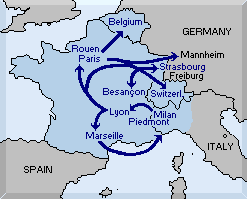 |
Meanwhile, the "Italian tarot" began to return back
to Italy, this time following the cultural and commercial
routes that bound the two countries. At first it reached Piedmont, in the first half of
the 18th century, and almost one century later also Lombardy, thus developing into
two distinct regional patterns. While the Lombard one survived until the first
decades of the 20th century before subsiding again, the Piedmontese version,
somewhat more naive, is still in production and used for playing.
The complicated geographic routes of the patterns belonging to group C are summarized
in the small map on the left, while the following scheme shows its graphic evolution. |
graphic evolution of trump no.1, the Trivial Performer, in patterns of group C
|
2 of Coins from NC and 2 of Cups from IK,
featuring the relevant manufacturer's name |
|
Up to the late 19th century it was not uncommon for major playing card
manufacturers to produce tarots in the pattern of Marseille, besides the varieties
traditionally used by local players.
These cards, though, would have probably remained popular only in their native areas, had
the tarot of Marseille never been used for cartomancy.
Disregarding a few early attempts of fortune-telling by individuals, which had really
never caught the public's interest (also due to religious restrictions), this activity was
born when a Parisian wine-merchant named Alliette wrote
Etteilla ou manière de se recréer avec un jeu de cartes
("Etteilla or the way of entertaining oneself with a deck of cards"); Etteilla was
Alliette's name in disguise.
|
|
Soon after, philosopher Court de Gébelin, a scholar of
esoteric practices, developed a theory by which the 78 cards of the tarot
had been created in Egypt as the pages of a book, in very ancient times, in
a golden age which he called "the primitive world"; this was also the title of
his extensive work in eight volumes; the last one was dedicated to the tarot.
This stirred Alliette's interest: he transferred onto the 78-card deck the
fortune-telling techniques he claimed, wrote a further work
Manière de se recréer avec le jeu de cartes nommées Tarots ("the way of
entertaining oneself with the deck of cards called Tarots"), and finally
had a deck with particular illustrations specially made for himself, to fit his
theories: the first cartomancy tarot known (1788).
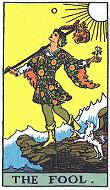
Ryder-Waite Tarot: the Fool |
During the 1800s, the Romantic movement acted as a perfect milieu for spreading
cartomancy and similar practices - and with them the tarot itself - to countries where this type of cards had never been used. This gives reason for the fact that in most parts of the world, Marseille's pattern
is still today considered "THE tarot".
By the turn of the 20th century, extravagant theories and interpretations had kept developing up to
the point that new tarot patterns were designed; some died out very soon, but others became rather
famous, such as the Ryder-Waite (left). Although their illustrations were modified so to
comply with the new meanings and interpretations, the 78 subjects and the ordering of the trumps
(the latter renamed "major arcana") remained faithful to the original tarot of Marseille. |
MARSEILLE'S INNOVATIONS
By the time the Cary sheet was printed, the tarot patterns were not yet
fully standardized.
Before judging whether a new detail is a steady change, or simply the
occasional result of an artist's whimsical interpretation, a comparison should
be made with all the main tarot varieties known, i.e. the ones produced earlier in time, as well
as the ones that followed, in order to track down the historical and geographic evolution
of the detail as much as possible.
A first consideration is that the tarot of Marseille states in full the names of the subjects,
clearing all the picture cards (including the courts) from any doubt about what each illustration
shows. Had this feature appeared at an earlier stage, changes such as
the Old Man turned into the Hermit, or Lightning turned into
the Tower (see below), would have likely never occurred.
However, the cards in the Cary sheet still lack their names, as well as those belonging to other early
tarots of the same age (around 1500); since the spelling of the earliest titles is constantly in French,
we may reasonably believe that the 22 definitions were added after the cards were
taken to France, where players not yet accustomed to the many allegories of the
new deck needed a reminder to understand the subjects. Such explicative purpose may also
give reason for some differences among the old editions known, underlined
in the table below. The original Italian names, translated in French, were probably
maintained as long as they still made good sense to the local players (see the case of
the Hanged Man, described in part 2). |
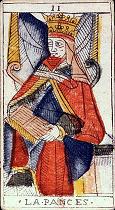
unusual name LA PANCES
for the Popess by J.Dodal
(early 18th century) |
The following table lists the 22 trumps of the tarot of Marseille with their modern French
names. It also indicates some variants found in old tarots of this type (see list of editions below),
from which we see how common names such as
the Star changed spelling very often,
while unusual subjects such as
the Wheel of Fortune or
the House of God
strangely remained stable. In most cases these changes are due to misspelling or to
a rough typesetting, but in a few cases they reflect real differences. In particular,
for
the Fool the use of
le Fou (variously spelt as
le Fol, le Foux, etc.)
seems preferred in old editions, while later ones adopted
le Mat.
I · LE BATELEUR
the trivial performer
|
VIII · LA JUSTICE
justice
JUSTICE (JD) (JN) |
XV · LE DIABLE
the devil
|
II · LA PAPESSE
the popess
LA PANCES (JD) |
VIIII · L'HERMITE
the hermit
LERMITE (JD) (JN) |
XVI · LA MAISON DIEU
the house of God
|
III · L'EMPERATRICE
the empress
L'IMPERATRICE (IK) (NC)
IMPERATRIS (JD)
LEMPERATRISE (JN)
|
X · LA ROUE DE FORTUNE
the wheel of fortune
|
XVII · L'ETOILE
the star
LESTOILE (IK)
LE·TOILLE (JD)
LESTOILLE (JN)
LETOILLE (NC) |
IIII · L'EMPEREUR
the emperor
LEMPEREUR (JN) |
XI · LA FORCE
strength
FORCE (JD) (JN) |
XVIII · LA LUNE
the moon
|
V · LE PAPE
the pope
|
XII · LE PENDU
the hanged man
LE·PANDU (JD) |
XVIIII · LE SOLEIL
the sun
|
VI · L'AMOUREUX
the lovers
LAMOUREUX (IK) (JN) (NC)
LA·MOUREU (JD)
|
XIII · LA MORT
death
name omitted (IK) (JD) (NC)
|
XX · LE JUGEMENT
Judgement
|
VII · LE CHARIOT
the chariot
LE·CHARIOR (JD)
|
XIIII · LA TEMPERANCE
temperance
TEMPERANCE (IK) (JD) (NC)
LEMPERANCE (JN) |
XXI · LE MONDE
the world
|
|
LE MAT
the fool
LE FOL (JD)
LE FOU (JN) |
|
IK · Ignaz Krebs - Freiburg, second half 18th c.
JD · Jean Dodal - Lyon, 1701-1715
JN · Jean Noblet - Paris, mid 17th century
NC · Nicolas Conver - Marseille, 1760
|
· NOTE ·
in old typesetting, the letter I was often used for
J, and V was used for
U: these have not been considered as true variants |
Instead, design and ranking remained quite steady.
Any such change might have brought different implications, according to the cards
involved.
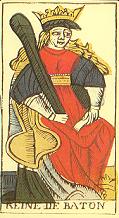
IK - queen of Batons |
In fact, for the 56 suit cards a new look would have not caused any specific consequence,
as the number of pips or the court personage, i.e. the card's rank,
would have remained the same as before. But for any of the 22 trumps a change in design
or ordering could have easily affected the moral meaning that
the card was originally meant to convey.
We should not forget that the trumps
were very likely created as allegories, whose details "spoke" to the players by means
of the symbols they featured, graphic metaphors that only a certain level of knowledge enabled to
understand, and by means of their ordering, which defined the moral ranking of the
principles they represented.
Therefore, any apparently insignificant shift from the original scheme could have easily
affected the conceiled meaning. |
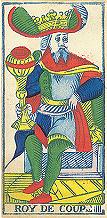
NC - king of Cups |